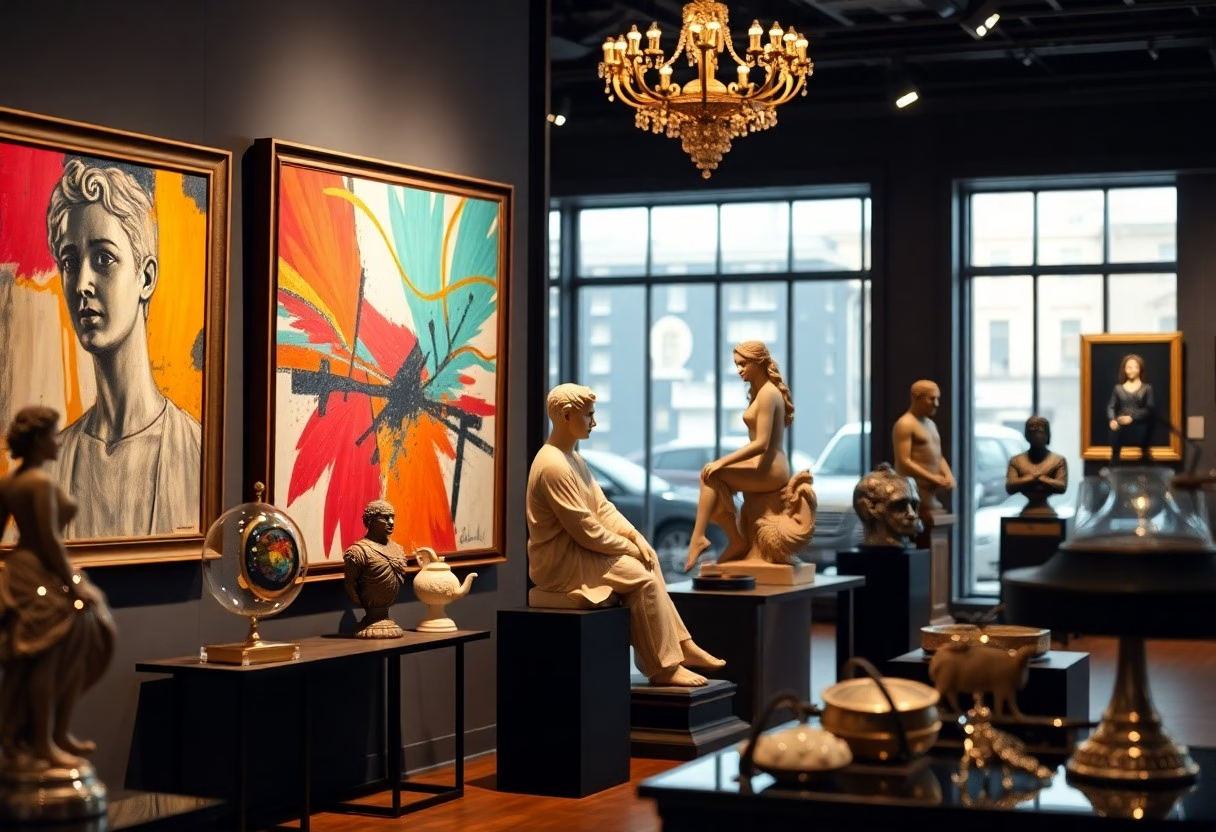Many aspiring investors overlook the vibrant world of art and collectibles, potentially missing out on a lucrative asset class. Understanding the intricacies of investing in art can seem daunting, but with the right approach, you can transform your passion into profit. Diverse opportunities await in this market, from classic paintings to contemporary sculpture, each offering unique growth potential. By leveraging expert insights and resources, such as Art as an Asset Class: Maddox unveils a Canvas of …, you can navigate this investment landscape confidently.
Key Takeaways:
- Educate Yourself: Understand the art market, artists, and the types of collectible assets available to make informed investment decisions.
- Assess Authenticity and Provenance: Ensure the artwork or collectible has verified authenticity and a clear history to maintain value and avoid forgeries.
- Diversify Your Collection: Just like traditional investments, spreading your funds across various artworks and collectibles can mitigate risks and enhance potential returns.
1. Research art markets and emerging trends thoroughly.
2. Set a realistic budget for your art investments.
3. Build relationships with reputable galleries and auction houses.
4. Focus on artists with proven appreciation potential.
5. Diversify your collection across styles and periods.
6. Keep documentation and insure your valuable pieces securely.
The Financial Landscape of Art and Collectibles
The financial landscape surrounding art and collectibles can be both compelling and complex, offering unique opportunities for investors. Unlike traditional investments, the art market operates on a different set of rules, influenced by trends, cultural significance, and emotional resonance. Understanding this landscape allows you to navigate its intricacies effectively, making informed decisions that align with your investment goals.
The Market Dynamics: Supply, Demand, and Value
In the art world, supply and demand significantly influence value. Limited editions, rare pieces, and works by established artists tend to appreciate over time, driven by strong demand from collectors and investors alike. Economic conditions, trends in taste, and the growing recognition of art as an asset class are vital elements affecting market dynamics and determining the worth of a piece.
Historical Performance: Tracking Returns Over Time
Art has demonstrated substantial resilience as an investment, with various studies indicating that it can yield returns comparable to or surpassing those of equities. The Art Market Report reveals that certain segments within the art market have appreciated by over 10% annually in the past decade. However, individual performance can vary widely based on artist reputation and market fluctuations.
Diving deeper into historical performance, you’ll find that blue-chip art—pieces from recognized artists like Picasso, Warhol, and Basquiat—often shows more consistent returns than lesser-known works. For example, works by Picasso have achieved auction prices exceeding $100 million, making them not only cultural treasures but also financial powerhouses. Furthermore, art indices, such as the Mei Moses index, track pricing across the auction markets, showing a robust annualized return of 6% to 7% over the long term. Evaluating these trends may guide you in identifying potential high-value investments in the art world.
Navigating the Art Scene: Gathering Knowledge and Insights
To successfully invest in art, immerse yourself in the art world. This means familiarizing yourself with different styles, movements, and key players. Attend art fairs, gallery openings, and exhibitions to interact with artists, collectors, and galleries, gaining insights into market dynamics and emerging trends. Build a robust network within the community, as personal connections can lead to exclusive opportunities and insider knowledge that can help guide your investment choices.
Identifying Trends: What to Look for in Emerging Artists
Spotting potential in emerging artists requires a keen eye for innovation and market buzz. Look for artists whose work evokes strong emotional responses and initiates conversations, as these elements often signal a deeper connection with audiences. Pay attention to their exhibition history, critical acclaim, and collaborations with established galleries, which can hint at their growth potential. Additionally, watch for social media presence, as artists who cultivate online engagement tend to gain traction faster in today’s art climate.
Resources for Research: Books, Websites, and Galleries
Your search for information should begin with reputable resources that can provide insights into the art market. Numerous valuable books examine into art investment strategies, including classics like “The $12 Million Stuffed Shark” by Don Thompson, which dissects the economics of the art world. Online platforms such as Artsy and Artnet offer extensive databases on artists, auction results, and market trends, while local galleries frequently host talks and workshops with industry experts to deepen your understanding of the art landscape.
Investing time in research can significantly enhance your art investment strategy. Many successful investors rely on a combination of traditional literature and up-to-date online resources to stay informed. For instance, subscribing to newsletters like “The Art Market Monitor” allows you to receive timely updates on emerging trends and market fluctuations. Websites like ArtRank and MutualArt can provide data analytics on artists’ sales histories, further enabling you to make informed decisions. Engaging with galleries that cater to both established and emerging artists can also reveal hidden gems, allowing you to build a versatile and potentially lucrative collection.
Building a Strategic Portfolio: Diversification and Risk Management
Strategically building your art portfolio involves careful diversification to mitigate risk and maximize potential returns. This means investing across multiple categories, styles, and mediums rather than concentrating on specific artists or movements. By blending contemporary pieces with classic works, sculptures, and other collectibles, you create a more resilient portfolio capable of weathering fluctuations in the art market. The goal is to assemble a collection that provides both aesthetic enjoyment and financial stability.
Balancing Mediums: Paintings, Sculptures, and Beyond
Incorporating various mediums enhances your portfolio’s vitality. While paintings capture the imagination and often dominate sales, don’t overlook the potential of sculptures, photography, and digital art. Each medium offers unique value propositions, with sculptures generally appealing to collectors seeking tactile experiences, while digital art opens doors to emerging trends and technologies. By mixing different forms, you not only cater to diverse tastes but can also capitalize on distinct market demands.
Assessing Risk: Evaluating Art as a Financial Asset
Your ability to evaluate the risk associated with art investments is vital for making informed decisions. This includes understanding factors such as market liquidity, provenance, artist reputation, and current trends. Art can be less liquid than traditional assets like stocks, so you’ll want to consider how quickly you can sell if needed. Additionally, some artworks appreciate significantly over time, while others may not, underscoring the importance of thorough research and market analysis.
To investigate deeper into assessing art as a financial asset, consider conducting valuations and seeking expert opinions on potential acquisitions. Tracking auction results and galleries’ sales data can help shed light on price trajectories and market fluctuations, allowing you to form educated forecasts about future appreciation. Each piece’s authenticity, condition, and historical significance impact its long-term value, indicating that practical assessments should go beyond aesthetics alone. Engaging with reputable appraisers and consulting market reports will equip you to navigate the art investment landscape with confidence.

Connecting with the Right Experts: Networking and Relationships
Building connections with the right experts can greatly enhance your investment journey in art and collectibles. Engaging with established professionals in the field helps you gather insights, stay informed about market trends, and access exclusive opportunities. Forming strong relationships within the art community can lead to invaluable advice and mentorship, ultimately guiding your investment decisions to foster growth in your collection.
Finding Trusted Advisors: Dealers, Auction Houses, and Consultants
Identifying reliable advisors is key to navigating the art market successfully. Start by researching reputable galleries, experienced dealers, and established auction houses that specialize in your areas of interest. Attending art fairs and exhibitions offers firsthand experience to meet potential consultants who can provide expert analysis on artwork value, market trends, and investment strategies. Building relationships with these professionals can often open doors, offering exclusive access to hidden gems and market insights.
The Power of Community: Joining Collectors’ Groups and Forums
Engaging with collectors’ groups and online forums creates a vibrant community for sharing knowledge and experiences. These platforms not only facilitate discussions about current market conditions and emerging artists but also allow you to discover new investment opportunities. Networking with fellow collectors can lead to valuable partnerships, mentorships, and even access to private sales that would otherwise be unavailable.
Membership in these communities can provide you with a wealth of resources. For example, many groups host exclusive events, guest speakers, and workshops geared toward educating members about investment strategies, valuation techniques, and market analysis. Regular interactions with like-minded individuals help you stay informed about industry shifts and can even lead to collaboration on joint acquisitions, greatly expanding your collections and investment potential. Joining platforms like these not only enriches your understanding of art as an asset class but also strengthens your position within this unique marketplace.
From Acquisition to Liquidation: The Sales Process
Understanding the sales process for your art and collectibles is vital for maximizing returns. Whether you’re acquiring pieces to hold long-term or plan to sell them, knowing the pathway from purchase to sale can influence your overall strategy. Begin with research, assess your potential buyers, and be knowledgeable about the platforms and venues available for both acquisition and liquidation, as these can significantly impact the final sale price.
Best Practices for Buying: Auctions, Direct Sales, and Online Platforms
When buying art, utilize a mix of avenues: galleries, auctions, and online platforms. Each method has its unique perks; for instance, auctions can yield lower entry prices if you’re willing to compete, while direct sales through galleries can offer authentication and detailed provenance. Online marketplaces allow for a broad reach, but assess the credibility of the platform and seller to mitigate risks.
Selling Your Collection: Timing, Valuation, and Marketing Strategies
Strategic timing and accurate valuation are key components in selling your collection effectively. Seasonal market trends can elevate prices, and aligning your sale with high-profile exhibitions or art fairs may attract more buyers. Employ professional appraisers for clear valuations, and utilize social media, targeted email campaigns, or online galleries to market your pieces compellingly.
Taking the time to analyze the optimal moment to sell can significantly enhance your returns. Consider engaging with experts who can help time your sale to coincide with art market peaks. Professional appraisals not only provide a market value but also lend credibility to potential buyers. By leveraging multiple marketing channels—such as creating engaging social media content, hosting private viewings, or listing on reputable online platforms—you can reach a wider audience and showcase your collection effectively. Combining these strategies may create a perfect storm for drawing interested parties and ultimately securing better offers for your art investments.
Conclusion
Now that you have explored the important steps on how to invest in art and collectibles, you can confidently take the leap into this fascinating asset class. By understanding market trends, conducting thorough research, and curating your collection with purpose, you position yourself to potentially enhance your financial portfolio. Art can serve as both a passion project and a lucrative investment, allowing you to transform canvas into cash while also enjoying the beauty of your acquisitions. With strategic planning and informed decisions, your journey into the art world can be both rewarding and enriching.

